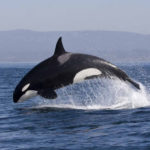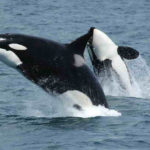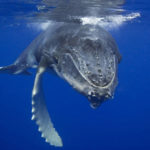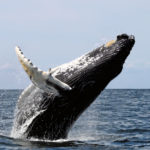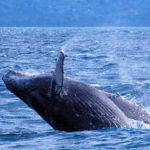Killer whales
 The reputation of a dangerous predator with a wide “taste” spectrum has made the killer whale an image of a tough assassin. Let’s try to figure this out really. Killer whales are the largest carnivorous dolphins. They eat literally all living things: fish, cephalopod mollusks, marine mammals. When food is enough, the killer whale peacefully coexists with other cetaceans, but if the killer whales are hungry, they attack without hesitation any rorquals and whales, other dolphins, pinnipeds, and even penguins. And the size of the victim does not matter: if it is large, the killer whale is a herd. When killing a victim with one blow does not work, killer whales exhaust her, biting off pieces of meat from her body. They bite their teeth in the throat of whales, tear his tongue, shred the fins.
The reputation of a dangerous predator with a wide “taste” spectrum has made the killer whale an image of a tough assassin. Let’s try to figure this out really. Killer whales are the largest carnivorous dolphins. They eat literally all living things: fish, cephalopod mollusks, marine mammals. When food is enough, the killer whale peacefully coexists with other cetaceans, but if the killer whales are hungry, they attack without hesitation any rorquals and whales, other dolphins, pinnipeds, and even penguins. And the size of the victim does not matter: if it is large, the killer whale is a herd. When killing a victim with one blow does not work, killer whales exhaust her, biting off pieces of meat from her body. They bite their teeth in the throat of whales, tear his tongue, shred the fins.
If the killer whale is attacked by the killer whale, then it is no longer possible to save it, it is doomed. Fast orcas, swimming at speeds of up to 55 km / h, simply can not be overtaken by the mother, who protects her child.
By blowing on the ice floe they roll into the water dormant seals, surrounding a herd of dolphins or walrus killer whales methodically destroy it in parts. Looking at hunting killer whales it is impossible not to admire how well and coolly they act. When one dolphin can not reach the victim, then others come to his aid. It’s amazing, but it seems that killer whales just love to kill: they push the seal from one side of the ice floe to get into the mouth of the relatives on the other side. No one pulls the blanket over. Without hurrying, they swim around the ice on which the seal has found the last resting place, raise the muzzle out of the water, as if making sure that the victim does not attempt to hide, roll large waves, trying to wash the poor fellow from the ice.
Killer whales have a complex social organization: females with cubs of both sexes make up a family. Several families, gathering together organize a grouping (from the English pod). The members of the group are very much attached to each other, the relations between its members are very warm and friendly. Healthy killer whales help the sick or old brothers and sisters. Active adults are active in the hunt, while females with cubs are on the sidelines, but nevertheless participate in the meal. Well, if a member of the group is dissatisfied with something, then the maximum he will do is indignantly slap the fin over the surface of the water.
Sometimes several factions are joined together for joint hunting or mating. Since members of the same grouping are related by related bonds, the pairing takes place between members of different groups. While meeting across the world’s oceans, killer whales do not enter only the Black and East Siberian seas.
Scientists distinguish two varieties of killer whales: homebodies and trespass killer whales.
Dominosides are killer whales that feed mainly on fish, and only in some cases look at pinnipeds. This type of killer whale is grouped into up to 15 individuals, going by a chain and looking for flocks of fish. The discovered shoal of a fish of the killer whale is knocked into the bowl on the surface of the water, stifles the fish with tails and one by one dives into the center of the pack. For the sake of justice, it is worth noting that these home-stayers, or resident killer whales do not at all correspond to the nickname of whale-killers. Their behavior and way of feeding resembles humpback whales.
The second type of killer whale is a transit killer whale. These are the real killers. In their diet, other dolphins, whales, pinnipeds, sea otters, sea lions. There is evidence that killer whales attack deer and moose, which swim through small canals. Interesting observation: traces of killer whale bites were found in half of the examined finnales, sei whales and 65% of sperm whales. Imagine – every second sperm whale in its life was attacked by an orcas.
Transitive killer whales gather in smaller groups, compared with the homebody. The group consists of 3 to 5 individuals. A distinctive feature of this group is its “taciturness”, since the mammals on which killer whales are hunting can hear their voices.
Hunting for seal killer whales use natural shelters in the bottom relief. And in the ambush sits one male, and the other members of the group are waiting at a distance. When hunting for sea lions, killer whales are thrown ashore, catching animals unawares. This method of hunting is the most spectacular, and it can be regularly observed on the shores of Patagonia.

